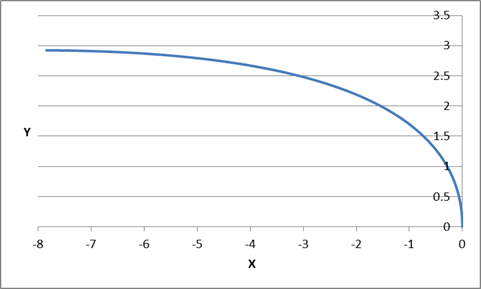
a. At this instant, is the particle in FIGURE Q4.1 speeding up, slowing down, or traveling at constant speed?
b. Is this particle curving to the right, curving to the left, or traveling straight?
a.
The state of the particle: speeding up, slowing down or traveling at constant speed.
Answer to Problem 1CQ
Solution:
The particle is slowing down in the vertical axis and speeding up in the horizontal axis.
Explanation of Solution
The acceleration vector has a component that it is pointing in the opposite direction to velocity vector; this means the particle will slow down on this axis. The component in the horizontal axis will make the particle to speed up.
Given Info:
There is a constant speed vector at the vertical axis and a constant acceleration vector with a component at both axes.
Formula Used The particle has the next velocity vector equation:
Where:
It is negative because it is pointing to the left.
It is negative because it is pointing downward.
Where a and v are the magnitudes of acceleration and velocity vector respectively.
Calculation
Substituting these values in the equation of velocity vector:
Conclusion
As we can see in the equation of velocity vector, the horizontal component is continuously increasing in the negative direction and the vertical component is slowing down since the initial velocity vector and the component of the acceleration vector are pointing in opposite directions.
b.
The shape of the particle trajectory.
Answer to Problem 1CQ
Solution:
The particle curves to the left.
Explanation of Solution
Given Info:
There is a constant speed vector at the vertical axis and a constant acceleration vector with a component at both axes.
Every second, the velocity vector changes the position vector as well as the acceleration vector changes the velocity direction and magnitude. As we can see the acceleration vector is partially pointing to the left, therefore the velocity vector will be changing in that direction and so the position vector.
Formula We can obtain the position equation from the previous problem:
Calculation
We can graph the last equation, and assuming the values:

Conclusion
As we can see, the particle trajectory curves to the left because the acceleration vector has a component on the horizontal axis which points the same way.
Want to see more full solutions like this?
Chapter 4 Solutions
PHY F/SCIENTIST MOD MASTERING 24 MO
Additional Science Textbook Solutions
Biology: Life on Earth with Physiology (11th Edition)
Human Biology: Concepts and Current Issues (8th Edition)
Campbell Essential Biology with Physiology (5th Edition)
Chemistry: An Introduction to General, Organic, and Biological Chemistry (13th Edition)
Genetic Analysis: An Integrated Approach (3rd Edition)
Biology: Life on Earth (11th Edition)
- Please solve this problem correctly please and be sure to provide explanation on each step so I can understand what's been done thank you. (preferrably type out everything)arrow_forwardUse a calculation to determine how far the fishing boat is from the water level .Determine distance Yarrow_forwardNo chatgpt pls will upvote Already got wrong chatgpt answerarrow_forward
- 2. 1. Tube Rating Charts Name: Directions: For the given information state if the technique is safe or unsafe and why. 60 Hertz Stator Operation Effective Focal Spot Size- 0.6 mm Peak Kilovolts MA 2 150 140 130 120 110 100 90 80 70 2501 60 50 40 30 .01 .02 .04.06 .1 .2 .4.6 1 8 10 Maximum Exposure Time In Seconds Is an exposure of 80 kVp, 0.1 second and 200 mA within the limits of the single phase, 0.6 mm focal spot tube rating chart above? Is an exposure of 100 kVp, 0.9 second and 150 mA within the limits of the single phase, 0.6 mm focal spot tube rating chart above?arrow_forwardQ: You have a CO2 laser resonator (λ = 10.6 μm). It has two curved mirrors with R₁=10m, R2= 8m, and mirror separation /= 5m. Find: R2-10 m tl Z-O 12 R1-8 m 1. Confocal parameter. b= 21w2/2 =√1 (R1-1)(R2-1)(R1+R2-21)/R1+R2-21) 2. Beam waist at t₁ & t2- 3. Waist radius (wo). 4. 5. The radius of the laser beam outside the resonator and about 0.5m from R₂- Divergence angle. 6. Radius of curvature for phase front on the mirrors R₁ & R2-arrow_forwardNo chatgpt pls will upvotearrow_forward
 Classical Dynamics of Particles and SystemsPhysicsISBN:9780534408961Author:Stephen T. Thornton, Jerry B. MarionPublisher:Cengage Learning
Classical Dynamics of Particles and SystemsPhysicsISBN:9780534408961Author:Stephen T. Thornton, Jerry B. MarionPublisher:Cengage Learning Physics for Scientists and Engineers with Modern ...PhysicsISBN:9781337553292Author:Raymond A. Serway, John W. JewettPublisher:Cengage Learning
Physics for Scientists and Engineers with Modern ...PhysicsISBN:9781337553292Author:Raymond A. Serway, John W. JewettPublisher:Cengage Learning Glencoe Physics: Principles and Problems, Student...PhysicsISBN:9780078807213Author:Paul W. ZitzewitzPublisher:Glencoe/McGraw-Hill
Glencoe Physics: Principles and Problems, Student...PhysicsISBN:9780078807213Author:Paul W. ZitzewitzPublisher:Glencoe/McGraw-Hill Principles of Physics: A Calculus-Based TextPhysicsISBN:9781133104261Author:Raymond A. Serway, John W. JewettPublisher:Cengage Learning
Principles of Physics: A Calculus-Based TextPhysicsISBN:9781133104261Author:Raymond A. Serway, John W. JewettPublisher:Cengage Learning Physics for Scientists and Engineers: Foundations...PhysicsISBN:9781133939146Author:Katz, Debora M.Publisher:Cengage Learning
Physics for Scientists and Engineers: Foundations...PhysicsISBN:9781133939146Author:Katz, Debora M.Publisher:Cengage Learning Physics for Scientists and Engineers, Technology ...PhysicsISBN:9781305116399Author:Raymond A. Serway, John W. JewettPublisher:Cengage Learning
Physics for Scientists and Engineers, Technology ...PhysicsISBN:9781305116399Author:Raymond A. Serway, John W. JewettPublisher:Cengage Learning





